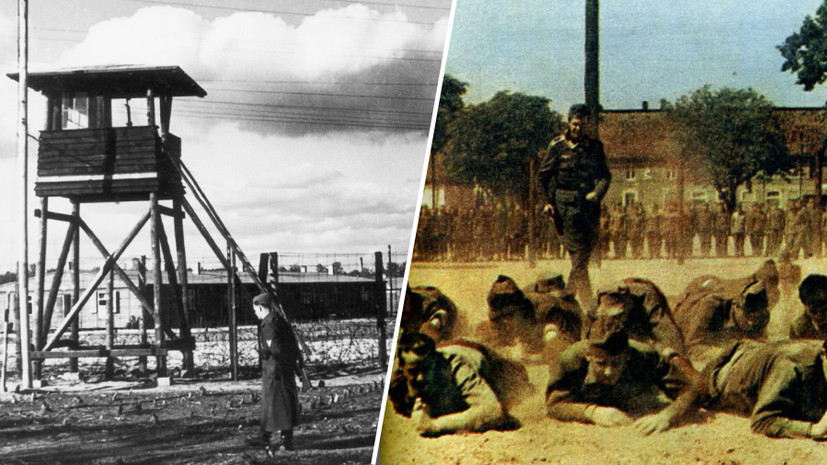On July 20, 1940, the Games of the XII Olympiad were to begin - such an official name would have been the main four-year competitions that were entrusted to Finnish Helsinki. However, the International Olympic Committee had to cancel the competition due to the outbreak of World War II a year earlier. Again, as 24 years earlier, the main sports festival of the world did not take place.
However, the games did take place, but in a completely different form and on different scales. Prisoners of war of the German Stalag XIII-A in Langwasser near Nuremberg organized their own Olympics in 1940 among prisoners from different countries.
The story of the competitions, held in secret from the German warders, to this day was reported by one of the Polish prisoners of war, Theodor Nevyadomsky, who became the "champion" of the Olympics for prisoners. He wrote the book "There was my front ...", which tells about unusual competitions. His story also formed the basis of the Polish film "Olympics 40" directed by Andrzej Kotkowski, released in 1980.
Nevyadomsky was captured after an unsuccessful attempt to escape from the environment along with surviving fellow soldiers in 1939. He fled twice, after which he ended up in that same Stalag XIII-A. It collected prisoners of war from different countries, captured by the military forces of Germany - Poles, French, Belgians, Dutch, Norwegians, British, Yugoslavs and even Senegalese who fought on the side of France. It was in this international company that the idea was born to organize its own Olympiad instead of the canceled one, in order to raise the spirit among fascist slaves.
To add weight to the competition, prisoners of war held a secret session of the International Olympic Committee in the camp infirmary, which was attended by supposedly sick representatives of Poland, France and the UK. The fact that the camp is planned to hold competitions, knew only one representative of the guard - the German soldier Roger Virion, whose father was French and his mother Polish.
The prisoners recalled that Virion was in love with the Polish javelin thrower, the bronze medalist of the 1936 Olympics, Maria Kwasniewski and always kept her photograph with him. Perhaps that is why he helped organize competitions in camp dungeons and keep a secret about them.
Before the start of the competition, the prisoners made a real Olympic flag out of a shirt. On it, the Polish archer Maciej Kolasa made a solemn oath on behalf of the participants.
“In the name of all athletes whose stadiums are surrounded by barbed wire, let these Olympic prisoners of war prisoners be a symbol of the Games of the XII Olympiad. I declare the 1940 International Olympic Games of Prisoners of War in Stalag XIII-A in the vicinity of Nuremberg open, ”said Kolas, although no one could hear his words.
The program of the Olympics included volleyball and five more personal disciplines, in each of which one representative from different countries could participate. The first set of awards was played in cycling. To determine the winner, Virion attached an old bicycle to two stools and installed a counter that responded to pedal movements. The best in this race in one place was a captive from Belgium.
The shot put turned into a shot of a six-kilogram cobblestone, which Virion passed from one hut to another. The victory in this discipline was won by the Frenchman, whose shell flew 11 meters away. Then came the raffle in archery, which had to be carried out not on the street, but indoors. All the same Virion helped to collect the inventory, and the Senegalese prisoner of war with Polish roots turned out to be the most accurate.
To win the long jump, it was necessary to overcome a small ditch with water, located on the camp. The best in this competition was recognized Norwegian. If the previous four disciplines were managed in secret from the overseers, then with the raffle in volleyball had to be canceled. The German guard noticed how the Belgians and the Dutch throw the ball over the clothesline and dispersed the “athletes”.
The last kind of Olympics for prisoners of war was the race "camp frog." Participants had to overcome 50 meters by jumping in a squat. It was a common way of punishing prisoners in the camps, and he entered the competition program as a symbol of disobedience to the Nazi machine. The victory was won by the same Nevyadomsky, who, by his own admission, with his indiscipline was able to masterfully train in jumping and easily get ahead of all competitors.
Soon Nevyadomsky escaped from captivity for the third time, and this time his attempt was successful. He took various artifacts with him, which served as proof that in 1940 the Olympic Games of prisoners of war came to replace the Olympics, uniting people of different nationalities in the same way as real competitions.

